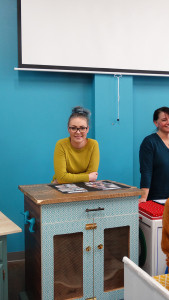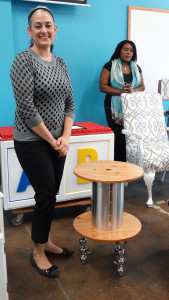 Habitat for Humanity partnered with the Sustainable Design program at Sinclair Community College for the second year, giving students the opportunity to embrace the process of recycling and choosing a piece of furniture at Habitat’s ReStore to repurpose.
Habitat for Humanity partnered with the Sustainable Design program at Sinclair Community College for the second year, giving students the opportunity to embrace the process of recycling and choosing a piece of furniture at Habitat’s ReStore to repurpose.
“It’s an opportunity to influence environments and meet the needs of people either through some tactical needs, or social or psychological needs,” said Donna Kronenberger, a student who took a small table and repurposed it into an ottoman.
Diana Leakas, design professor, teaches the IND 2140 Sustainable Design class at Sinclair, which focuses on understanding environmental issues, ecosystems and ethics, in relationship to built environments. Students learn how to incorporate interior design with ethic responsibility of culture and nature.
“I really wanted the students to understand what type of talent they might have inside of them that they didn’t realize that they already had, so it was a good critical thinking process for them—a good time to work with their hands and many times they did not have the [opportunity before],” Leakas said.
 Habitat for Humanity is an organization that works toward a common goal of building families, not homes. According to Habitat’s ReStore manager, Phil Kloos, one of the biggest misconceptions of Habitat for Humanity is that they give away houses for the working poor.
Habitat for Humanity is an organization that works toward a common goal of building families, not homes. According to Habitat’s ReStore manager, Phil Kloos, one of the biggest misconceptions of Habitat for Humanity is that they give away houses for the working poor.
“We build people houses; an energy efficient house and they buy it. They get a 30-year mortgage on it. It’s a zero interest mortgage, which we carry. So we’re a mortgage company that is a charity, a retail store and a construction company,” Kloos said. “We do that with 19 employees currently—we truly are a volunteer driven organization.”
 Habitat for Humanity ReStores are nonprofit home improvement stores and donation centers that sell new and gently used furniture and home goods at a fraction of the retail price. The proceeds are used to build homes, communities and hope.
Habitat for Humanity ReStores are nonprofit home improvement stores and donation centers that sell new and gently used furniture and home goods at a fraction of the retail price. The proceeds are used to build homes, communities and hope.
“There are almost 900 ReStores across the country. It’s a new brand and we’re a thrift—all of our profits go to our local mission,” Kloos said.
All Habitats are separate corporations, but all tithe to the mother ship, according to Kloos.
“We give people a hand up, not a hand down,” Kloos said. “We’re the eighth most respected brand in the world, we don’t take that lightly—our reputation is everything.”
This project is about committing to recycling, and keeping things out of landfills, so the design students put down their pens and picked up tools to complete this project, according to Leakas. Students are challenged to design a residential or commercial structure with minimum impact on the environment. The final project teaches students how to integrate sustainable strategies with the use of interior design.
 “Up to this point [students] do not have the opportunity to do that other than just drawing…but the ability to build and step back and take a look at what they built and understand that they were the ones that created this is important,” Leakas said.
“Up to this point [students] do not have the opportunity to do that other than just drawing…but the ability to build and step back and take a look at what they built and understand that they were the ones that created this is important,” Leakas said.
Kronenberger said her favorite part was the process, and determining what would be the outcome. “My favorite part of the process was deconstructing and reconstructing… and figuring it out how to make the pieces go back together,” Kronenberger said.
She said it took her approximately 42 hours to complete her project, which ended up being a plush, patterned ottoman, with storage on the inside, alongside candle sticks made out of what were originally table legs. She’s donating her piece to the ReStore which will give another person the chance to purchase the piece for their home.
“I’m curious what kind of price [ReStore] is going to put on it, and who the end user will be,” Kronenberger said. “You know it’s going into someone else’s house—you’ve done something that someone else will be getting enjoyment out of.”
 After completing the assignment for class, the last part of the project was to present the repurposed piece to Habitat for Humanity at the ReStore on West Riverview in Dayton, Ohio. Leakas said she hopes students are empowered by this project, and realizes how important it is to be aware of the environment by incorporating their design skills they have learned in class.
After completing the assignment for class, the last part of the project was to present the repurposed piece to Habitat for Humanity at the ReStore on West Riverview in Dayton, Ohio. Leakas said she hopes students are empowered by this project, and realizes how important it is to be aware of the environment by incorporating their design skills they have learned in class.
“I think it’s very empowering and for the students, it’s number one to see how items can be repurposed and not always tossed away. And hopefully as they tell their story to other people, then other people may start to think too. Keeping things out of the landfill is very very important,” Leakas said.
Gabrielle Sharp
Executive Editor

